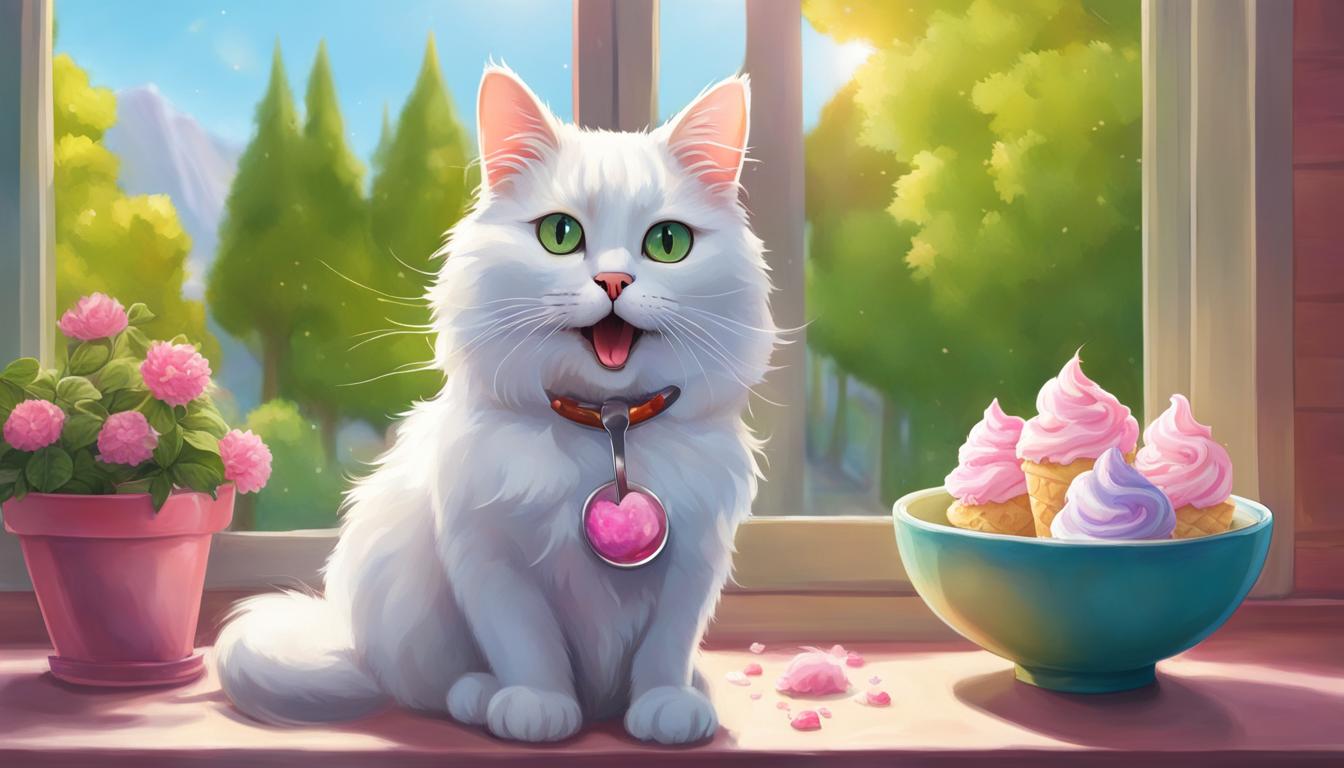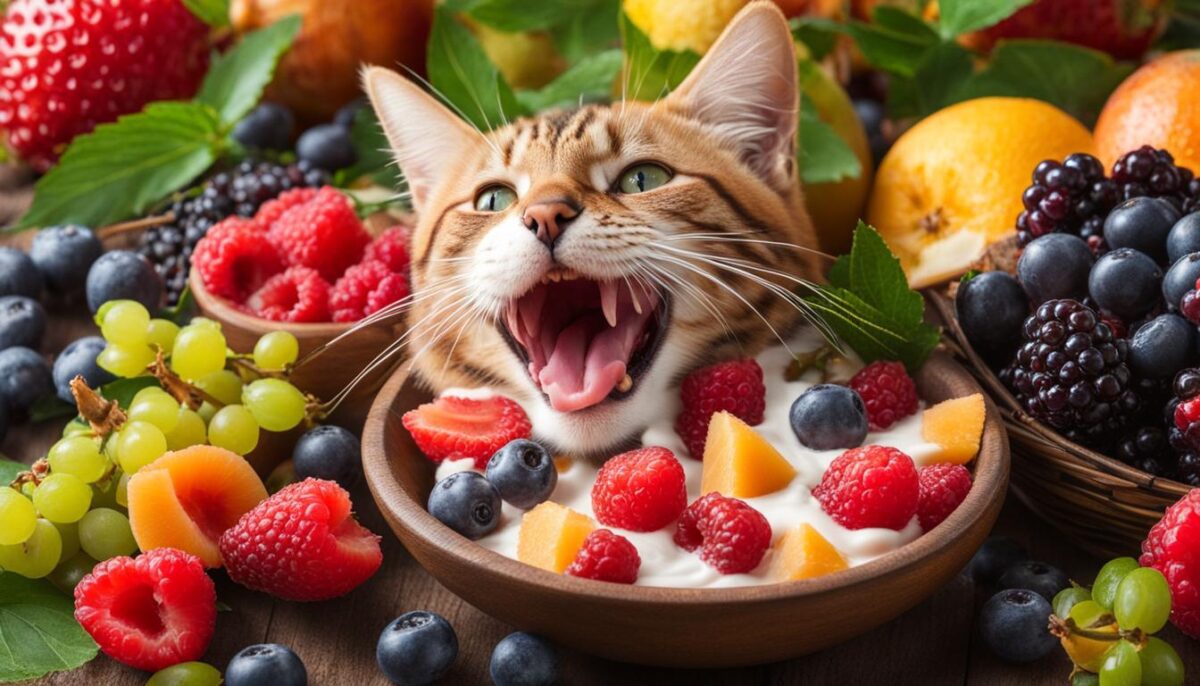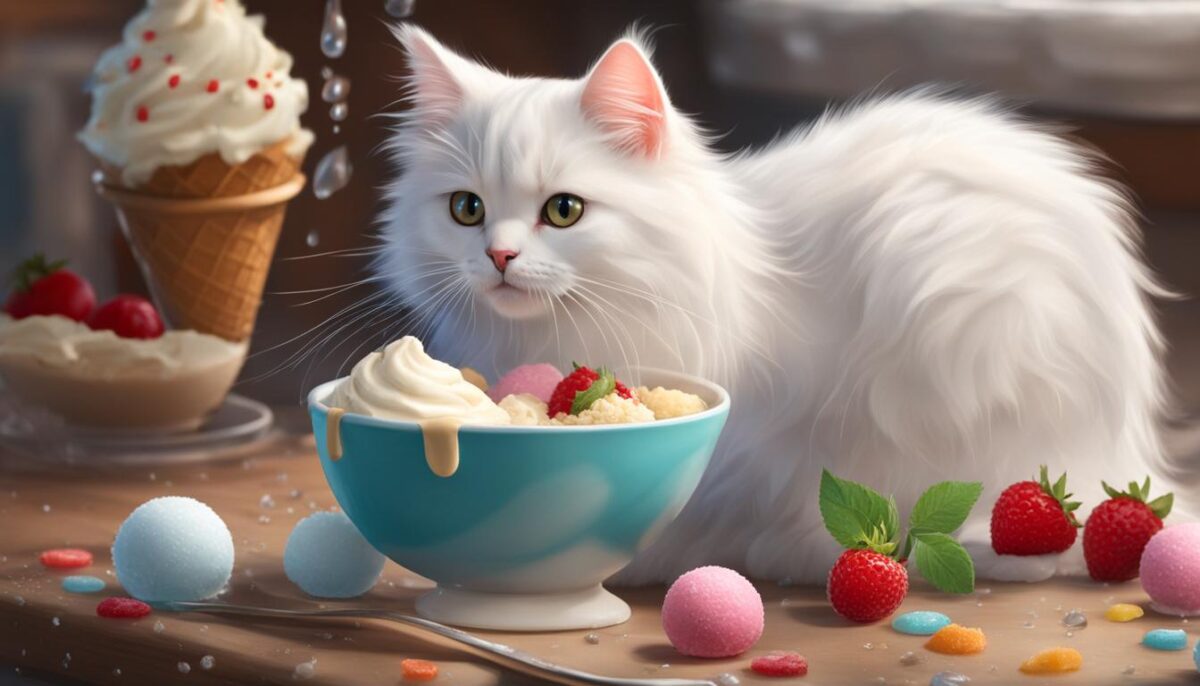As a cat owner, you may have wondered whether it’s safe for your feline friend to indulge in a lick of ice cream. While it may be tempting to share your favorite sweet treat with your furry companion, it’s important to consider their unique dietary needs and potential risks. In this article, we’ll explore whether cats can enjoy ice cream and what alternatives are available to keep them happy and healthy.
Key Takeaways:
- Cats are obligate carnivores and their bodies are designed to derive nutrition primarily from meat.
- Most ice creams contain ingredients that are unsuitable for cats, such as lactose, which they cannot properly digest.
- Chocolate ice cream is toxic to cats and should be kept away from them.
- There are healthier alternatives available for cats, such as cat-friendly ice creams or frozen treats made with ingredients that suit their dietary needs.
- Making homemade cat ice cream can be a fun and personalized treat for your furry friend using safe and cat-friendly ingredients.
Understanding Cats’ Dietary Needs
Cats have unique dietary needs that are essential for their health and well-being. As obligate carnivores, their bodies are designed to thrive on a diet primarily consisting of meat. Unlike humans and some other animals, cats cannot produce certain essential nutrients on their own and must obtain them from their food.
One of the key differences between cats and humans is their digestion. Cats have a shorter digestive tract and a higher metabolism, enabling them to process and absorb nutrients more efficiently from animal-based protein sources. They require a diet that is rich in high-quality protein to support their muscle development, organ function, and overall growth.
In addition to protein, cats also need essential fatty acids, such as omega-3 and omega-6, which are found in animal fats. These fatty acids play a crucial role in maintaining healthy skin and coat, promoting brain development, and supporting a strong immune system. Cats also require certain vitamins and minerals, including vitamin A, taurine, and calcium, which are essential for their eye health, heart function, and bone strength.
| Nutrient | Importance | Sources |
|---|---|---|
| Protein | Supports muscle development and organ function | Meat, poultry, fish |
| Fatty Acids | Maintains healthy skin and coat, supports brain development and immune system | Animal fats, fish oils |
| Vitamins and Minerals | Essential for eye health, heart function, and bone strength | Liver, eggs, fish |
It’s important to note that cats cannot properly digest certain substances found in plant-based foods, such as carbohydrates. While small amounts of carbohydrates are not harmful, cats do not have a biological need for them in the same way humans do. Feeding cats a diet high in carbohydrates can lead to weight gain, digestive issues, and other health problems.
Understanding your cat’s dietary needs and providing them with a balanced, meat-based diet is essential for their overall health and longevity. High-quality commercial cat food formulated to meet their specific nutritional requirements is widely available and recommended by veterinarians. These cat foods are carefully designed to provide the optimum balance of protein, essential fatty acids, vitamins, and minerals that cats need to thrive.
The Risks of Ice Cream for Cats
When it comes to offering ice cream to your feline friend, it’s important to consider the potential risks and their unique dietary needs. Cats are lactose intolerant, which means they lack the enzyme needed to properly digest lactose, the sugar found in milk and dairy products.
Feeding ice cream to cats can lead to digestive issues such as diarrhea and vomiting. The high sugar content in ice cream can also contribute to weight gain and other health problems. Additionally, certain flavors of ice cream, such as chocolate, can be toxic to cats due to the presence of theobromine.
“Cats are lactose intolerant and consuming ice cream can lead to digestive upset, including diarrhea and vomiting.”
It’s essential to prioritize your cat’s well-being and provide them with a diet that meets their nutritional requirements. While they may show interest in ice cream due to its appealing texture and temperature, it’s important to opt for safer alternatives that are specifically designed for cats.
| Risks of Ice Cream for Cats | Symptoms |
|---|---|
| Lactose intolerance | Diarrhea, vomiting, gastrointestinal discomfort |
| High sugar content | Weight gain, potential development of diabetes |
| Presence of toxic ingredients (e.g., chocolate) | Intoxication, tremors, seizures |
By understanding the risks associated with feeding ice cream to cats, you can make informed choices that prioritize their health and well-being. Opt for cat-friendly frozen treats or homemade alternatives that are free from lactose and other harmful ingredients. Always consult with your veterinarian before introducing any new foods into your cat’s diet to ensure they are safe and suitable.
https://www.youtube.com/watch?v=gYs9iLCBYMM
Cats’ Fascination with Ice Cream
Cats are known for their curiosity, and when it comes to ice cream, they can’t help but be attracted to its enticing qualities. The cool temperature and creamy texture of ice cream make it a sensory delight for cats. When they see, smell, or even hear the sound of ice cream being scooped, their interest is piqued.
However, it’s important to note that cats’ fascination with ice cream does not mean it is suitable or safe for them to consume. As obligate carnivores, their bodies are not designed to process dairy products like ice cream. Despite this, their curiosity and attraction to ice cream may still persist, leading them to approach and investigate when it’s present.
It’s crucial for cat owners to understand that while cats may show interest in ice cream, it is not a suitable treat for them. The risks associated with ice cream consumption, such as digestive issues caused by lactose intolerance or the toxicity of ingredients like chocolate, outweigh any momentary pleasure they may experience. Therefore, it’s best to avoid letting your cat have any ice cream and instead opt for safer alternatives that are specifically formulated for feline dietary needs.
So, the next time your cat shows a fascination with ice cream, resist the temptation to share this treat with them. Instead, consider providing them with cat-friendly frozen treats or homemade alternatives that prioritize their health and well-being. Remember, your cat’s dietary needs should always come first, even when their curiosity is piqued by tempting treats like ice cream.
Safer Alternatives for Cats
If you’re looking for safer alternatives to regular ice cream for your beloved feline friend, there are options available that are specifically designed with cats in mind. These cat-friendly ice creams and frozen treats are formulated to meet cats’ dietary needs while providing a delicious and enjoyable experience. Here are some of the safer alternatives for cats:
- Cat-friendly ice cream: Many pet stores offer ice creams that are specially made for cats. These ice creams are often low in lactose or completely dairy-free, making them easier for cats to digest. They come in a variety of flavors and textures, ensuring that there’s something for every cat’s taste.
- Frozen treats made with cat-safe ingredients: You can also make your own frozen treats for your cat at home. Using ingredients like pureed chicken, fish, or even fruits and vegetables that are safe for cats, you can create delicious frozen treats that your cat will love. Just make sure to avoid any ingredients that are harmful to cats, such as chocolate or artificial sweeteners.
Offering these safer alternatives can provide your cat with a refreshing and enjoyable treat without compromising their health. Just remember to introduce new foods gradually and in moderation to ensure your cat’s digestive system adjusts well to the change.
Remember, it’s always best to consult with your veterinarian before introducing any new foods or treats into your cat’s diet, especially if your cat has any specific dietary restrictions or health concerns. Your veterinarian can provide personalized advice and guidance based on your cat’s individual needs.
Making Homemade Cat Ice Cream
While store-bought ice cream may not be suitable for cats, you can still treat your feline friend to a cool and tasty dessert with homemade cat ice cream. By using cat-friendly ingredients and simple recipes, you can create frozen treats that are safe and enjoyable for your furry companion.
Easy Cat-Friendly Ice Cream Recipes
There are several cat-friendly ice cream recipes that you can try at home. Here are a few simple options:
- Tuna Puree Ice Cream: Blend canned tuna with a small amount of water or tuna juice. Pour the mixture into ice cube trays and freeze until solid. Serve a small portion as a refreshing treat.
- Wet Food Puree Ice Cream: Mix your cat’s favorite wet food with a small amount of water to create a smooth puree. Pour the mixture into ice cube trays and freeze. Your cat will love licking up this delicious frozen treat.
- Hidden Treat Surprise: Place a small treat, such as a freeze-dried chicken piece, in each compartment of an ice cube tray. Pour water or low-sodium chicken broth over the treats and freeze. Your cat will have fun licking the ice cream and discovering the hidden treasures inside.
Remember to serve homemade cat ice cream in moderation. It’s best to thaw it slightly before serving, as cats may find it difficult to eat extremely cold treats. By offering homemade cat ice cream, you can provide your feline friend with a special treat that is both safe and enjoyable.
Thanksgiving Foods for Cats
Thanksgiving is a wonderful time to celebrate with family and indulge in delicious meals. As a cat owner, you may be wondering if you can share some of the holiday foods with your feline friend. While cats can enjoy certain Thanksgiving foods, it’s important to be mindful of their dietary needs and safety. Here are some safe options for your cat to enjoy during the Thanksgiving festivities.
Turkey
Turkey can be a great treat for cats during Thanksgiving. Plain, cooked turkey without any seasoning or bones is safe for your furry friend to enjoy. It provides a good source of protein and can be a tasty addition to their diet. Remember to remove the skin and any excess fat before serving it to your cat.
Vegetables
Some vegetables commonly served during Thanksgiving, such as carrots and green beans, can be given to cats in small portions. These veggies are low in calories and can provide additional fiber and nutrients to your cat’s diet. Make sure to cook them until they are soft and easy to chew for your cat.
Avoid Harmful Foods
While it’s tempting to share all the delicious Thanksgiving treats with your cat, there are some foods that should be avoided as they can be harmful to cats. Onions, garlic, and foods that contain them should never be given to cats as they can cause damage to their red blood cells. Additionally, cats should not consume sweets, chocolate, or fatty foods, as these can lead to digestive issues and even toxic reactions.
Remember to always serve Thanksgiving treats to your cat in moderation. Large quantities of new foods can upset their stomachs. It’s best to introduce new foods gradually and observe their reaction. By offering safe and appropriate Thanksgiving foods, you can include your cat in the holiday celebration while keeping them healthy and happy.
| Safe Thanksgiving Foods for Cats | Avoid These Foods |
|---|---|
| Turkey (plain, cooked) | Onions and garlic |
| Carrots (cooked) | Sweets and chocolate |
| Green beans (cooked) | Fatty foods |
Conclusion
In conclusion, it’s important to prioritize your cat’s dietary needs and safety when it comes to indulging in ice cream and Thanksgiving treats. Cats are obligate carnivores, and their bodies are designed to derive nutrition primarily from meat. Most ice creams contain ingredients that are unsuitable for cats, such as lactose, which they cannot properly digest.
While cats may show an interest in ice cream, consuming it can lead to digestive issues like diarrhea and vomiting. Chocolate ice cream is particularly dangerous for cats as it contains theobromine, which is toxic to them. To provide a safer and more enjoyable option, there are cat-friendly ice creams and frozen treats available at pet stores that are specifically formulated to meet cats’ dietary needs.
When it comes to Thanksgiving foods, it’s important to be cautious. Plain, cooked turkey and certain vegetables like carrots and green beans can be enjoyed by cats in moderation. However, foods like onions, garlic, sweets, and fatty foods should be avoided as they can be harmful. Treats should be served in small portions and can be made interactive for play and exercise.
By understanding your cat’s dietary needs and making informed choices, you can ensure your furry companion stays happy and healthy. So, next time you’re tempted to share ice cream or Thanksgiving treats with your cat, remember to opt for safer alternatives and limit their intake to safe and appropriate options.
FAQ
Can cats eat ice cream?
Cats should not eat ice cream. Most ice creams contain ingredients that are unsuitable for cats, such as lactose, which they cannot properly digest. Vanilla ice cream may be milder, but it can still cause digestive issues in cats. Chocolate ice cream is toxic and should be kept away from cats.
Why can’t cats have ice cream?
Cats are obligate carnivores and their bodies are designed to derive nutrition primarily from meat. They lack the enzyme lactase, which is necessary to break down lactose. Cats’ digestive systems are not designed to process dairy products like ice cream. Consuming ice cream can lead to digestive upset in cats, including diarrhea and vomiting.
Are there any alternatives to ice cream for cats?
Yes, there are healthier alternatives available for cats. Many pet stores offer specially formulated cat-friendly ice creams or frozen treats that are low in lactose or free of dairy altogether. These treats are designed to meet cats’ dietary needs and provide a safer and more enjoyable option for them.
Can I make ice cream for my cat at home?
Yes, you can make homemade cat ice cream using lactose-free alternatives like cottage cheese, yogurt, or special cat milk. There are various simple recipes available, such as tuna puree, wet food puree, and hidden treat surprises. It’s important to remember moderation and to allow the ice cream to thaw slightly before serving to your cat.
What other foods can cats enjoy?
Cats can enjoy plain, cooked turkey and certain vegetables like carrots and green beans in moderation. However, they should avoid foods like onions, garlic, sweets, and fatty foods as these can be harmful to cats. Treats should be served in small portions and can be made interactive for play and exercise.
Should I share Thanksgiving foods with my cat?
It’s best to prioritize your cat’s dietary needs and safety. While plain, cooked turkey and certain vegetables can be offered in moderation, other Thanksgiving foods should be avoided. Ice cream, in particular, can pose risks to cats due to their lactose intolerance and the potential presence of toxic ingredients like chocolate. By understanding your cat’s dietary needs and making informed choices, you can ensure your furry companion stays happy and healthy.


